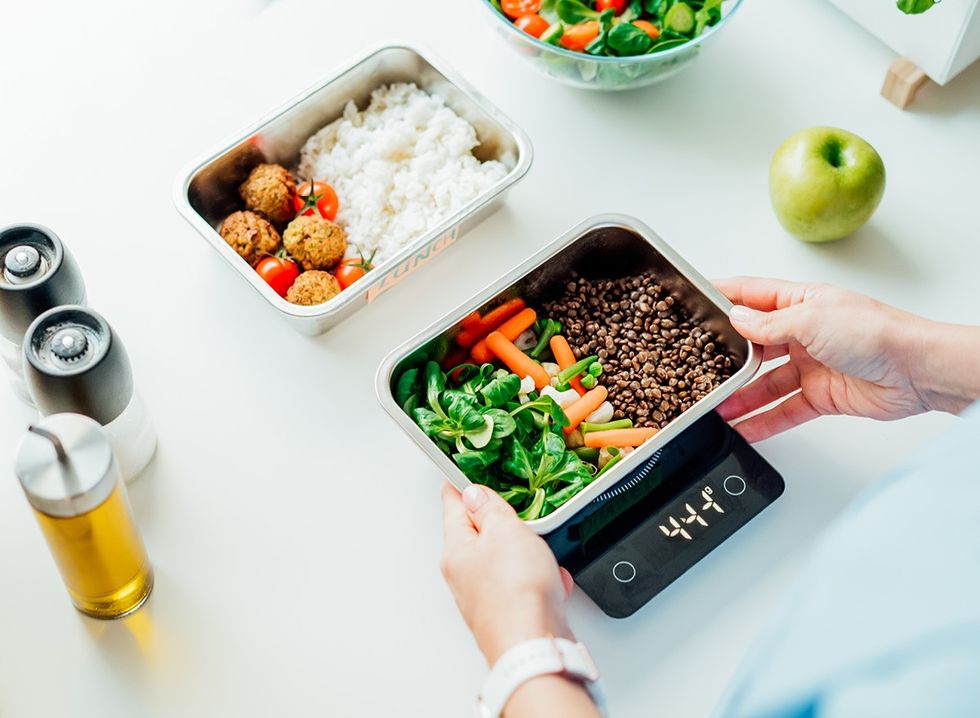Have you noticed that no matter how much you diet or exercise, that stubborn belly fat just won't budge? According to food scientist and Gauge Girl Training founder Christine Hronec, the answer lies in your hormones. "The reason why hormone imbalances are so important is because they change the distribution of body fat," she explains. "If you have ever dealt with stubborn belly fat, particularly the hormonal belly, it is typically a result of an imbalance in the female sex hormones."
What Is Hormonal Belly Fat
Before diving into solutions, it's crucial to understand what causes hormonal belly fat. "When you do not ovulate regularly, whether you're in perimenopause, menopause, if you're having irregular periods, what happens is your body does not get to release excess estrogens," Christine explains in her post. This creates a cascade effect that leads to stubborn fat accumulation, particularly around the midsection.
Why Your Body Needs Healthy Fats
"Dietary fat consumption does not cause fat gain," Christine emphasizes. She explains a crucial misconception: "So many people think that if you eat fat, you're going to get fat and that is not true." In fact, dietary fat is essential for hormone balance and regular ovulation. "Fat is essential for fertility," she adds, explaining how proper fat intake helps maintain regular hormonal cycles.
RELATED:8 High-Protein Foods with Nearly Zero Calories That Melt FatThe Critical Role of Fiber
"If you are insufficient in dietary fiber, you could be in a state of estrogen dominance," Christine warns. While the average person consumes less than 10 grams of fiber daily, she recommends at least 20 to 25 grams for hormone balance. "The absolute number of your estrogen count doesn't matter," she explains. "It's the amount relative to progesterone." This balance is crucial for preventing hormonal belly fat.
Why You Need More Zinc
Zinc plays a dual role in hormone balance and immune health. "Supplementing with zinc will naturally lower your estrogen and raises the progesterone levels up," Christine explains. "This is also effective for men as well, not just women alone." She recommends zinc-rich foods such as "oysters, beef, chicken, seeds, nuts, legumes, as well as mushrooms."
The Vitamin C Connection
"Experts have shown that vitamin C doses of at least 750 milligrams per day has been shown to naturally boost progesterone levels," Christine notes. This is particularly important because "low levels of vitamin C are common among women who miscarry as well as women who have preterm pregnancy." She recommends getting vitamin C through "cruciferous vegetables, leafy greens, tomatoes, strawberries, guava, kiwi, as well as snow peas."
RELATED:7 Simple Daily Exercises To Shrink Hanging Belly FatMissing Magnesium
"Over one third of the United States population is deficient in magnesium," Christine reveals. Even more concerning, "50% of people with heart disease actually have magnesium deficiency." This crucial mineral "does help to naturally eliminate estrogen through a detoxification process in the liver." She recommends rich sources including "dark chocolate, avocado, nuts, seeds, fatty fish, whole grains, spinach, quinoa, and legumes."
The Impact of Environmental Factors
"The pesticides that are found in just conventional agriculture are disruptive to your hormonal system," Christine explains. These hormone disruptors are so concerning that they "are prohibited in certain countries." This highlights the importance of choosing clean, organic foods whenever possible.
Choosing Clean Animal Products
When it comes to animal products, Christine warns about conventional farming methods: "If you think of cows and chickens and different things, the way they've been raised, if they've been pumped and loaded with lots of hormones to increase the yield of their weight, to increase egg production for chickens, those animals are going to be loaded with unnatural levels of hormones." Her solution? "You want to always go for organic, natural, pasture-raised anytime you're able to, non-GMO."
Creating Your Hormone Reset Plan
To reset your hormones and target belly fat, follow these science-backed steps:
- Include healthy fats in your diet to support hormone production
- Increase fiber intake to at least 20-25 grams daily
- Add zinc-rich foods to your meals
- Boost vitamin C consumption through whole foods
- Incorporate magnesium-rich foods daily
- Choose organic produce and hormone-free animal products when possible.
Long-Term Success Strategy
"Again, as you are able to, as you can afford to in your budget," Christine advises about making these changes. This acknowledges that transforming your diet is a journey, not an overnight change. The key is making consistent progress toward better hormone balance through sustainable changes to your diet and lifestyle choices.
Remember, as Christine explains, hormone balance isn't about quick fixes. It's about creating sustainable changes that support your body's natural hormone balance. By addressing these six key areas, you can work towards reducing hormonal belly fat and improving your overall health. And if you enjoyed this article, take advantage of these 15 Quick Ways to Lose Body Fat Percentage in a Week













 Shutterstock
Shutterstock Shutterstock
Shutterstock Shutterstock
Shutterstock Shutterstock
Shutterstock Shutterstock
Shutterstock Shutterstock
Shutterstock Shutterstock
Shutterstock

 Shutterstock
Shutterstock Shutterstock
Shutterstock Shutterstock
Shutterstock Shutterstock
Shutterstock Shutterstock
Shutterstock Shutterstock
Shutterstock Shutterstock
Shutterstock Shutterstock
Shutterstock Shutterstock
Shutterstock

 Olive OilShutterstock
Olive OilShutterstock It's Now Part Of My LifeShutterstock
It's Now Part Of My LifeShutterstock Beans and Lentils: The Hunger-Fighting Fiber ChampionsShutterstock
Beans and Lentils: The Hunger-Fighting Fiber ChampionsShutterstock SalmonShutterstock
SalmonShutterstock 12 Surefire Ways to Lose Abdominal Fat, Say ExpertsShutterstock
12 Surefire Ways to Lose Abdominal Fat, Say ExpertsShutterstock Chronic StressShutterstock
Chronic StressShutterstock Shutterstock
Shutterstock Remember:Shutterstock
Remember:Shutterstock

 I'm a Nutritionist and These 9 High-Protein Snacks Keep My Clients Full While Losing 50 Pounds
I'm a Nutritionist and These 9 High-Protein Snacks Keep My Clients Full While Losing 50 Pounds
 Shutterstock
Shutterstock 2. Processed FoodsShutterstock
2. Processed FoodsShutterstock Shutterstock
Shutterstock Shutterstock/Prostock-studio
Shutterstock/Prostock-studio Shutterstock
Shutterstock Pro TipsShutterstock
Pro TipsShutterstock Shutterstock
Shutterstock Shutterstock
Shutterstock Shutterstock
Shutterstock Shutterstock
Shutterstock Don’t Drink as Much AlcoholShutterstock
Don’t Drink as Much AlcoholShutterstock Most Women on GLP-1s Are Making a Few Common MistakesShutterstock
Most Women on GLP-1s Are Making a Few Common MistakesShutterstock Soda and Sugary DrinksShutterstock
Soda and Sugary DrinksShutterstock Shutterstock
Shutterstock Eat BreakfastShutterstock
Eat BreakfastShutterstock And Improve Insulin SensitivityShutterstock
And Improve Insulin SensitivityShutterstock Belly Flab Strip Tip: Sugar and Fat Calories Leave Its Mark on Your BodyShutterstock
Belly Flab Strip Tip: Sugar and Fat Calories Leave Its Mark on Your BodyShutterstock Shutterstock
Shutterstock The Drugs Mimic the GLP-1 Hormone Naturally Produced by the BodyShutterstock
The Drugs Mimic the GLP-1 Hormone Naturally Produced by the BodyShutterstock 3. Deep-Fried ItemsShutterstock
3. Deep-Fried ItemsShutterstock